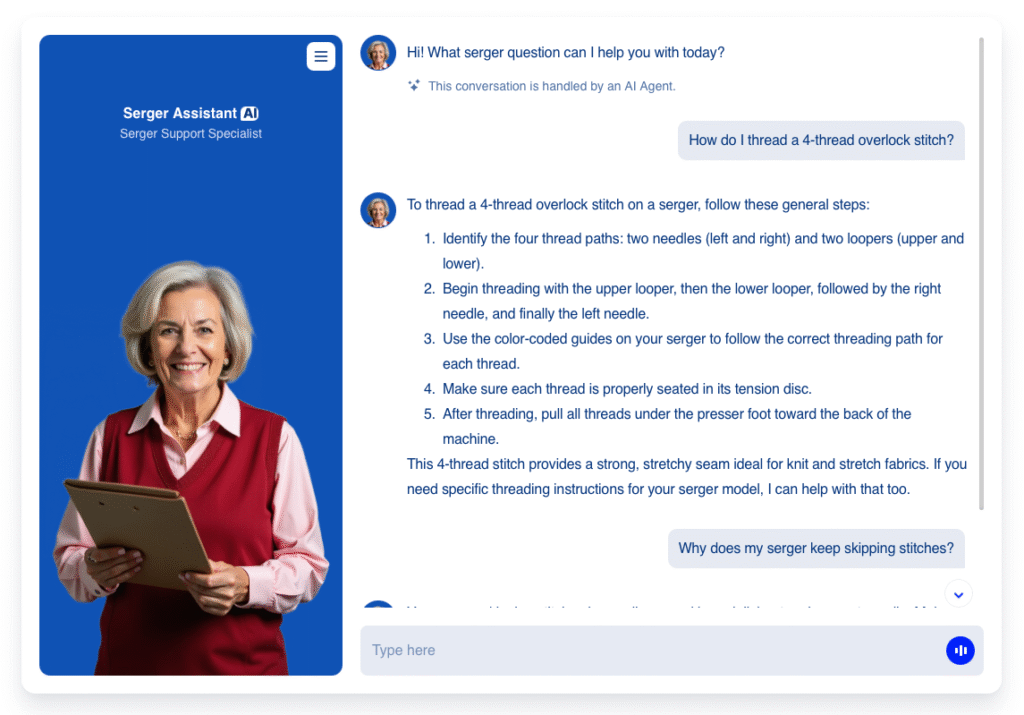
Serging Assistant
Your 24/7 Serging Expert!
The Serging Assistant is your personal guide to everything serging! Whether you’re just learning how to thread a serger or you’ve been using one for years, this assistant is here to explain techniques, answer questions, and help you achieve professional finishes on every project.
Sergers can feel intimidating—with multiple threads, loopers, tension settings, and stitch types to manage. The Serging Assistant breaks it all down into clear, simple steps so you can stitch with confidence.
Yearly Subscription
Pay for a Year Upfront-
Serger Assistant
-
Needle Assistant
👉 Subscribe today for as low as $9.99/month and start stitching with confidence!.
What the Serging Assistant Does for You
This assistant is trained on a wide range of serging knowledge, including:
- Serger machine basics (threading, loopers, knife settings, tension, maintenance)
- Choosing the right stitch type: overlock, rolled hem, flatlock, coverstitch, and more
- Matching the correct threads, needles, and fabrics for each project
- Troubleshooting issues like skipped stitches, loose loops, or uneven edges
- Tips for creating professional seam finishes, stretchy seams, and decorative effects
- Best practices for cleaning and maintaining your serger for long life
Think of it as having a serger coach by your side—ready to answer “how” and “why” in plain, everyday language.
Ask Away for Expert Advice
- How do I thread a 4-thread overlock stitch?
- Why is my serger looping too loosely on the edge?
- Which settings should I use for a rolled hem on chiffon?
- What’s the best thread for serging knits?
- Why does my serger keep skipping stitches?
- How do I balance tension for a flatlock seam?
- Can I use a serger to construct a whole garment?
- What’s the difference between a serger and a coverstitch machine?
- How often should I change my needles in a serger?
- What’s the easiest way to clean lint from my serger?

Why You'll Love It
✨ The Serging Assistant is here to make serging approachable and fun, giving you the knowledge you need for smoother seams, better finishes, and stress-free sewing. Think of it as having a serger coach by your side—ready to answer “how” and “why” in plain, everyday language.
Q&A Examples
Q: What’s the difference between an overlock stitch and a coverstitch?
A: An overlock stitch trims the fabric edge while wrapping it with thread for a clean, finished seam—great for construction and finishing. A coverstitch, often done on a separate machine, creates parallel lines of stitching on the top and a looper chain on the back, perfect for hemming stretch fabrics.
Q: Why are my stitches uneven when serging knits?
A: Uneven stitches usually mean the differential feed setting needs adjusting. Increasing the feed will help prevent stretching on lightweight knits, while lowering it will help ease in heavier fabrics.
Q: Can I use regular sewing thread in my serger?
A: Yes, but most people prefer cone thread made for sergers. It’s stronger, more economical, and designed to flow smoothly at high speeds. For decorative effects, you can also use specialty threads like wooly nylon.
Q: How often should I oil my serger?
A: Check your manual first, but generally a serger benefits from regular oiling every 8–10 hours of sewing. Keep the moving parts lubricated and always clean out lint before applying oil.
Q: Why does my fabric pucker when I serge lightweight material?
A: Puckering is often caused by too much tension or the wrong needle choice. Try reducing thread tension, using a smaller needle (like size 70/10), and adjusting the differential feed.
Ready to Get Started?
Yearly Subscription
Pay for a Year Upfront-
Serger Assistant
-
Needle Assistant